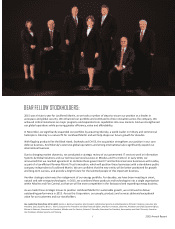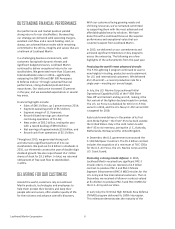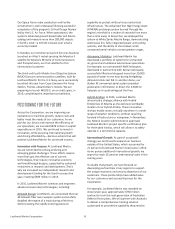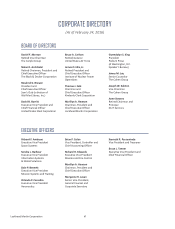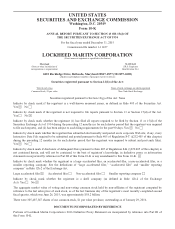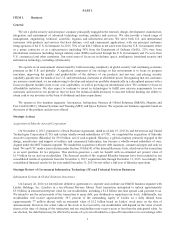Lockheed Martin 2015 Annual Report Download - page 13
Download and view the complete annual report
Please find page 13 of the 2015 Lockheed Martin annual report below. You can navigate through the pages in the report by either clicking on the pages listed below, or by using the keyword search tool below to find specific information within the annual report.sustainment activities. The development contracts are being performed concurrent with the production contracts. Concurrent
performance of development and production contracts is used for complex programs to test aircraft, shorten the time to field
systems and achieve overall cost savings. We expect the System Development and Demonstration portion of the
development contracts will be substantially complete in 2017, with less significant efforts continuing into 2019. Production
of the aircraft is expected to continue for many years given the U.S. Government’s current inventory objective of
2,443 aircraft for the Air Force, Marine Corps and Navy; commitments from our eight international partners and three
international customers; as well as expressions of interest from other countries. During 2015, we delivered 45 aircraft to our
U.S. and international partners, resulting in total deliveries of 154 production aircraft as of December 31, 2015. We have
114 production aircraft in backlog as of December 31, 2015, including orders from our international partners. For additional
information on the F-35 program, see “Status of the F-35 Program” in Management’s Discussion and Analysis of Financial
Condition and Results of Operations.
Aeronautics produces and provides support and sustainment services for the C-130J Super Hercules, as well as upgrades
and support services for the legacy C-130 Hercules worldwide fleet. We delivered 21 C-130J aircraft in 2015, including one
to international customers. We have 97 aircraft in our backlog as of December 31, 2015 with advanced funding from
customers for additional C-130J aircraft not currently in backlog. Our C-130J backlog extends into 2020.
Aeronautics currently produces F-16 aircraft for international customers. Aeronautics also provides service-life
extension, modernization and other upgrade programs for our customers’ F-16 aircraft. We delivered 11 F-16 aircraft in
2015. As of December 31, 2015, we have 20 F-16 aircraft in backlog with backlog extending into 2017.
Aeronautics provides sustainment services for the existing U.S. Air Force C-5 Galaxy fleet and modernization activities
to convert 49 C-5 Galaxy aircraft to the C-5M Super Galaxy configuration. These modernization activities include the
installation of new engines, landing gear and systems and other improvements that enable a shorter takeoff, a higher climb
rate, an increased cargo load and longer flight range. As of December 31, 2015, we had delivered 29 C-5M aircraft under
these modernization activities, including nine C-5M aircraft delivered in 2015. As of December 31, 2015, we have
20 C-5 aircraft in backlog with backlog extending into 2018.
While production and deliveries of F-22 aircraft were completed in 2012, Aeronautics continues to provide
modernization and sustainment activities for the U.S. Air Force’s F-22 aircraft fleet. The modernization program comprises
upgrading existing systems requirements, developing new systems requirements, adding capabilities and enhancing the
performance of the weapon systems. The sustainment program consists of sustaining the weapon systems of the F-22 fleet,
providing training systems, customer support, integrated support planning, supply chain management, aircraft modifications
and heavy maintenance, systems engineering and support products.
In addition to the above aircraft programs, Aeronautics is involved in advanced development programs incorporating
innovative design and rapid prototype applications. Our Advanced Development Programs (ADP) organization, also known
as Skunk Works®, is focused on future systems, including unmanned aerial systems and next generation capabilities for
advanced strike, intelligence, surveillance, reconnaissance, situational awareness and air mobility. We continue to explore
technology advancement and insertion in our existing aircraft. We also are involved in numerous network-enabled activities
that allow separate systems to work together to increase effectiveness and we continue to invest in new technologies to
maintain and enhance competitiveness in military aircraft design, development and production.
Information Systems & Global Solutions
In 2015, our IS&GS business segment generated net sales of $5.6 billion, which represented 12% of our total
consolidated net sales. IS&GS’ customers include various government agencies of the U.S. and other countries, military
services, as well as commercial and other customers. In 2015, U.S. Government customers accounted for 89%, international
customers accounted for 9% and U.S. commercial and other customers accounted for 2% of IS&GS’ net sales. IS&GS has
been impacted by the continued downturn in certain federal agencies’ information technology budgets and increased
re-competition on existing contracts coupled with the fragmentation of large contracts into multiple smaller contracts that are
awarded primarily on the basis of price.
5


